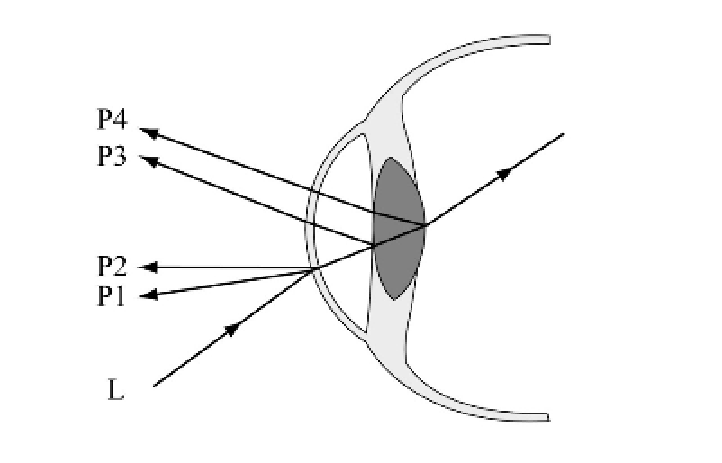Geography Reference
In-Depth Information
Currently the most exploited eye movement measurement method is remote eye-tracking,
also called the Pupil and Corneal Reflexion method. It relies on the measurement of visible
features of eye, e. g. pupil, iris-sclera boundary and corneal reflection of a closely situated
direct light source (often infra-red). The reflected light is recorded by a video camera or
specially designed optical sensor. The information is then analyzed to extract eye rotation
from changes in corneal reflections. The resulting corneal reflexion is also known as “glint”
or the 1st Purkinje reflexion (P1) [20].
There are at least four Purkinje images (figure 1). The first Purkinje image (P1) is the
reflection from the outer surface of the cornea. The second one (P2) is the reflection from the
inner surface of the cornea. The third one (P3) is the reflection from the anterior surface of
the lens and the last one (P4) is the reflection from the posterior surface of the lens. [21]
Eye position and gaze direction are estimated using information from an image sensors
picking up reflection patterns on the cornea and other information points. By image analysis
and mathematics a gaze point on a reference plane can be calculated.
Figure 1.
Four Purkinje images - the reflection (L) on different parts of the eye: P1 from the outer
surface of the cornea, P2 from the inner surface of the cornea, P3 from the anterior surface of the lens, P4
from the posterior surface of the lens. [22]
3.2. Eye movements and algorithms of their detection
Human eyes can only perceive a limited fraction of the visual world at one point in time.
Both eyes together provide a roughly elliptical view of the world which is approximately
200° of visual angle wide and 130° high. [23]
However not all parts of this view are perceived with equal acuity because the retina of the
eye has a varying structure and composition. The fovea, part of the retina, is responsible for

